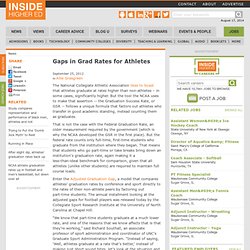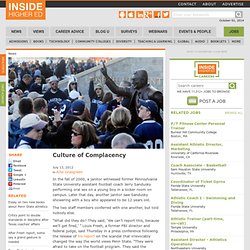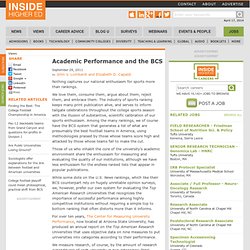

Report finds football players graduate at rates lower than full-time student peers. The National Collegiate Athletic Association likes to boast that athletes graduate at rates higher than non-athletes – in some cases, significantly higher.

But the tool the NCAA uses to make that assertion -- the Graduation Success Rate, or GSR -- follows a unique formula that factors out athletes who transfer in good academic standing, instead counting them as graduates. That is not the case with the Federal Graduation Rate, an older measurement required by the government (which is why the NCAA developed the GSR in the first place). But the federal rate counts only full-time, first-time students who graduate from the institution where they began.
That means that students who go part-time or take breaks bring down an institution's graduation rate, again making it a less-than-ideal benchmark for comparison, given that all athletes (unlike other students) are required to maintain full course loads. And using the AGG model does paint a different picture. Public university admissions officers lay out best practices for athlete admissions. DENVER – It’s a classic athlete admissions dilemma.

The coach of a high-profile program is seeking an exemption from admissions standards for a top recruit who doesn't meet the university's outlined admissions criteria. “If we don’t do make an exemption, someone else is going to, and we’re going to have to play against him,” the coach argues. There’s wide concern among flagship public universities – institutions that often have the most prominent athletic departments and most rigorous academic standards – that policies governing issues such as academic exemptions for athletes vary widely between institutions, creating an uneven playing field. For example, some institutions are required by state law to admit individuals who meet NCAA eligibility criteria.
Others have much stricter standards. “How do we handle these kinds of sensitive, high-stakes issues on campus?” For a copy of the ACAOPU report, e-mail: Wayne Sigler (wsigler@gmu.edu) Robert Barkley (rbrtbkl@clemson.edu) Why Don't More Athletes Take A Stand? - 07.09.12. PARDON ME, I'd like to interrupt your regularly scheduled programming and introduce you to America's rarest athlete: Wonman Joseph Williams. His first name's a Korean word that means full harmony, but you don't need to check his papers. He's a defensive back on a Division I football team. You know, a student-ATHLETE. He's a 19-year-old who stands up during team meetings at Virginia so that he won't fall asleep, but not because he's sluggish or disengaged. You see, he's attempting to do something that's nearly impossible at a college in the U.S. today.
Lotsa luck, kid! Wait. Full Harmony stares in puzzlement. He flashes a text to one of the Living Wage campaigners, a classmate named Hallie Clark: I didn't know y'all were hunger striking. We sure are, she replies. A thought and a nervous tickle run through him: He needs to join them. Freeh report faults Penn State athletics culture. In the fall of 2000, a janitor witnessed former Pennsylvania State University assistant football coach Jerry Sandusky performing oral sex on a young boy in a locker room on campus.

Later that day, another janitor saw Sandusky showering with a boy who appeared to be 12 years old. The two staff members conferred with one another, but told nobody else. “What did they do? They said, ‘We can’t report this, because we’ll get fired,’ ” Louis Freeh, a former FBI director and federal judge, said Thursday in a press conference following the release of his report on the scandal that irrevocably changed the way the world views Penn State. “They were afraid to take on the football program. “If that’s the culture on the bottom,” Freeh continued, “God help the culture on the top.”
“For the past several decades, the university’s athletic department was permitted to become a closed community. Distinctive But Not Unique The case at Penn State was horrific and unprecedented, to be sure. Structure Matters. Academic Performance and the BCS. Nothing captures our national enthusiasm for sports more than rankings.

We love them, consume them, argue about them, reject them, and embrace them. The industry of sports ranking keeps many print publication alive, and serves to inform tailgate celebrations throughout the college sports season with the illusion of substantive, scientific calibration of our sports enthusiasm. Among the many rankings, we of course have the BCS system that generates a list of what are presumably the best football teams in America, using methodologies praised by those whose teams score high and attacked by those whose teams fail to make the cut.
Those of us who inhabit the core of the university’s academic environment share the enthusiasm for measuring and evaluating the quality of our institutions, although we have less enthusiasm for the endless ranked lists that appear in popular publications. While some dote on the U.S.